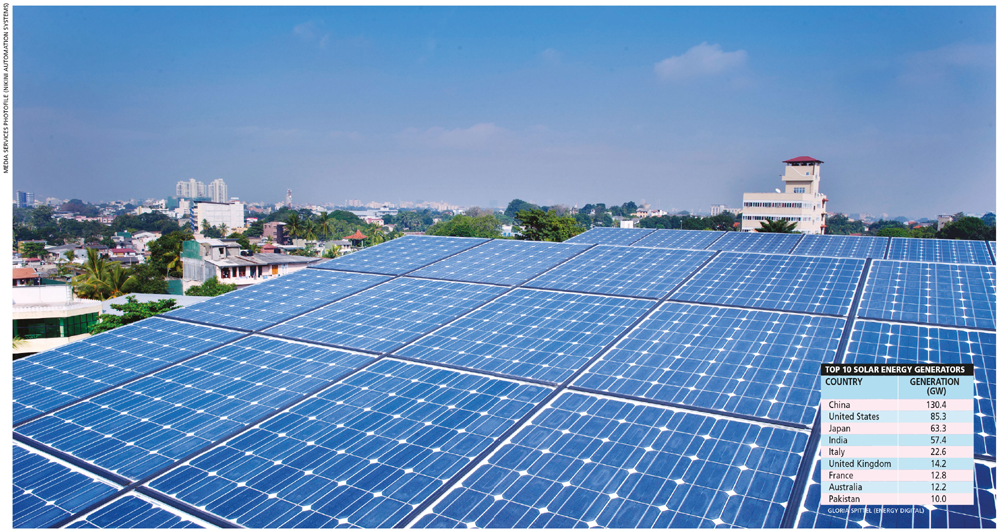GREEN ENERGY
THE BATTLE FOR SOLAR POWER
Gloria Spittel reflects on the myriad opportunities to harness energy from the sun
Electricity (or power as it is often colloquially referred to) is an essential resource for daily living – be it for leisure or business. Countless studies across the decades have proved how important this resource is for personal, business, community and eventually national development. This is because it enables various functions from the mundane yet essential reading light and food storage, to powering home based businesses and local factories – and probably more relevantly, powering the indispensable smartphone!
However, Sri Lanka does not enjoy universal access to electricity, which according to the World Bank stood at 95.6 percent of the population in 2016. That said, this is higher than the global average of 87.3 percent.
The Ministry of Power and Renewable Energy has stated that at the end of September 2015, only seven districts in Sri Lanka had 100 percent access to electricity – viz. Colombo, Gampaha, Kalutara, Galle, Matara, Hambantota and Kandy. Districts with the lowest access to electricity at the time were Kilinochchi (84%), Mullaitivu (87%), Mannar (87%) and Batticaloa (90%). All other districts had access covering more than 95 percent of their communities.
It appears that access is not Sri Lanka’s main energy related issue. Instead, the generation of clean, renewable and thereby sustainable power – and that too uninterrupted throughout the year – appears to be a challenge with which the authorities continue to grapple.
Perhaps in recognising the importance of clean and renewable energy, and its effects on reducing detrimental carbon emissions, and in line with international treaties on climate change, the Ministry of Power and Renewable Energy along with the Ceylon Electricity Board (CEB) and Sri Lanka Sustainable Energy Authority implemented the ‘Surya Bala Sangramaya’ (Battle for Solar Energy) programme in September 2016.
The programme outlines plans to reduce carbon emissions from thermal power generating plants by 150,000 MTs a year after 2020, while adding 200 MW and 1,000 MW to the national grid by 2020 and 2025 respectively. It also moots private consumer power generation through the installation of solar panels on rooftops to meet energy requirements with an option to sell any excess to the national grid.
However, the major obstacle to mass scale adoption of solar energy generation is the cost associated with necessary hardware such as panels and existing subsidies for current power consumption models. In the present context, while incentives for solar energy generation and consumption can only be instilled by the relevant authorities, the international market for solar panels and energy since 2016 could pave the way for its adoption in Sri Lanka.
Renewable, clean and sustainable energy comes in various forms including wind and solar. But harnessing these natural sources, and converting, storing and transmitting (in some cases, to areas not connected to national or local grids) can be expensive.
According to environmental agencies such as Greenpeace, global energy demand can be met by solar alone. However, this has remained a pipe dream for a while. But over the past two years, the international market for solar energy production has reflected a drop in the cost of generation of the resource.
Bloomberg reveals that solar energy is now cheaper than power generated by coal in many places, and is expected to fall below cost of wind and natural gas generated energy almost everywhere. However, whether the Sri Lankan market will follow this prediction is highly debatable.
It is interesting to note what’s causing the downward spiral in costs in the international market.
There is an abundant supply of solar panels led by China in manufacturing and installation. The technology to harness, convert and store solar energy has continued to improve through small but impactful innovations – for example, roof tiles that double as solar panels; and advances in battery technology for storing solar energy. China is making plans for roads to double as solar energy generating plants – and if this succeeds, it would lessen the need for land to be allocated for solar plants.
Consumer demand for renewable energy appears to be rising across the world as more people become aware of the critical nature of climate change.
For instance, solar in the US surpassed natural gas and wind as the largest source of new energy in the first quarter of this year – approximately 2.5 GW of energy was generated from solar, which represents an increase of 13 percent year on year and accounts for 55 percent of total new power generation.
In Sri Lanka, most of the country’s energy requirement (approximately 2,070 MW at peak and 10,500 GW annually) is met by thermal plants – mainly coal – and hydropower.
If the government is serious about its Battle for Solar Energy programme, now is the time to take advantage of the downtrend in solar energy costs in the international market – to lower the cost of a kW of power generated by solar energy from Rs. 23 in 2016 to less than the coal generated 15 rupees per kW – and thereby meet the country’s renewable energy goals.






Energy is a crisis in Sri Lanka. We just haven’t come around to accepting it as a ‘national conundrum.’ Mostly because we currently have hydro and coal powering our power plants and producing electricity. However, the future is in sustainable energy. Especially in a world where the electric car replaces the combustion engine vehicle.
Investing in renewable energy – solar and wind – in Sri Lanka would greatly help our ‘self-sustaining’ cause by miles. But can we make that leap of policy in good faith? That is the real issue here, not a potential commitment towards renewable energy.
Energy from the sun is limitless, it’s wireless and, what’s more, it’s absolutely free. This is a timely wake-up call for Sri Lanka.
This is an insightful article.